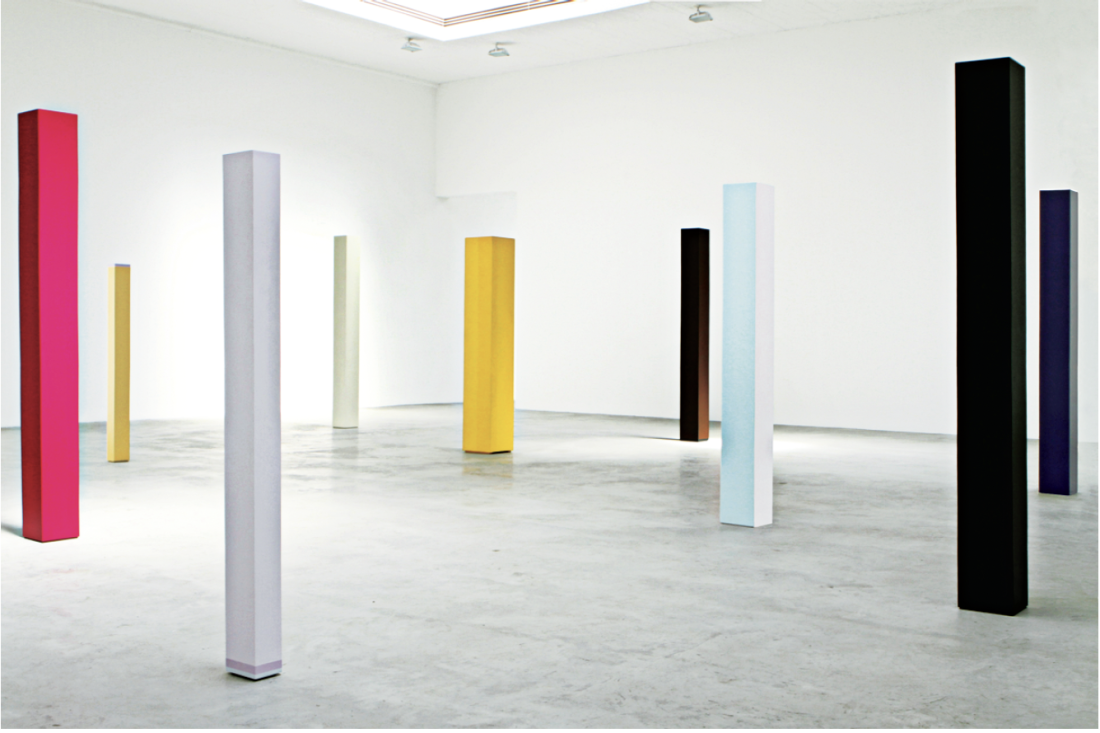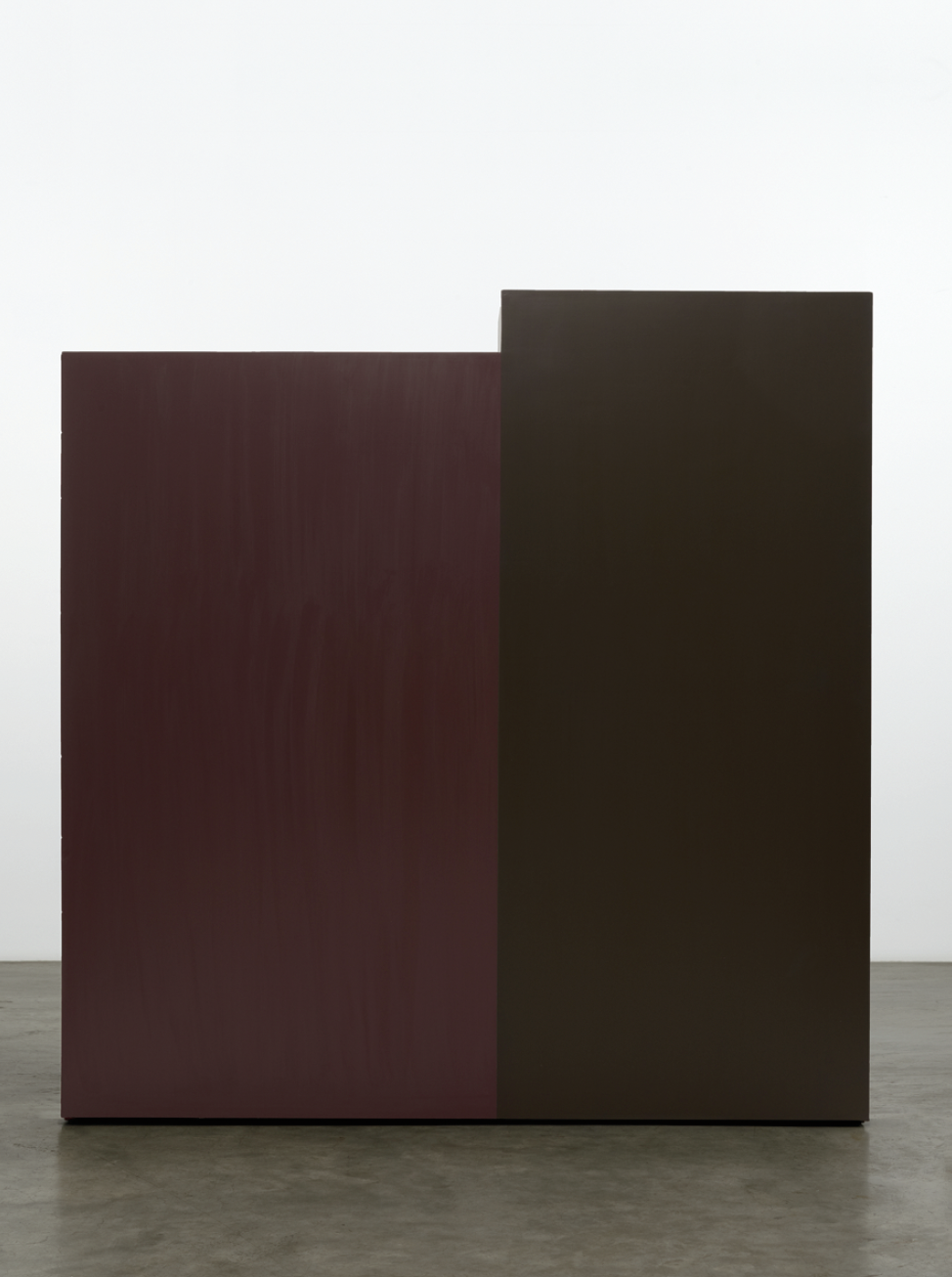Anne Truitt
Although “Anne Truitt: Sculpture 1962–2004” covers four decades of the artist’s career, the 15 sculptures on display in Matthew Marks’s largest Chelsea space barely evidenced the passing of these many years. This is hardly surprising, given Anne Truitt’s proclivity toward slow and steady production. Each of Truitt’s columns—there were 12 on display in the gallery’s main space—is a feat of patience and labour. Her painting technique involved straining and re-straining paint through a fine sieve, applying it in extremely thin layers and, once dry, sanding it with sandpaper to rid it of brush marks, a cycle she repeated again and again. Knowing this lends even further power to the monoliths, stunning statues of colour that hum in the space, each one life-size and at once confrontational and reassuring. The show also included three larger sculptures, each in its own peripheral space and out of view when you are standing in the midst of the colourful cathedral.

Installation view of “Anne Truitt: Sculpture 1962–2004” at Matthew Marks Gallery, New York, 2010. © Estate of Anne Truitt / The Bridgeman Art Library. Courtesy Matthew Marks Gallery, New York.
One of the foundational ideas that compels me to Truitt is her insistence on strict parameters and the uncovering of infinite variance within them. Titles such as Prescience, 1978, The Sea, The Sea, 2003, First Spring, 1981, Sun Flower, 1971, and Threshold, 1997, provide lyrical contexts for the different height, width and colour of the columns. Some works appear to hover slightly off the ground, their bases unseen beneath the bulk of the vertical shafts; others look monochromatic and reveal their complexities in time, as when eyes adjust to a suddenly darkened room. What at first seemed to be an all-over yellow suddenly reveals stripes, vibrating light and dark tones of lemon and ochre; pale blue on another work surprises with a reverse of stark white; a black cap tops off yet another. These variations are significant as formal puzzles and as indicators of a larger system, however playfully illogical. Viewed in the larger context of Minimalism, Truitt’s work also emerges as significant for its balance between fabrication and handcraft. From afar, these shafts of colour appear pre-fabricated. It is the exacting arbitrariness of her formal choices that track the artist’s singular taste and logic, in the process revealing her direct, labour-intensive involvement in the work’s production.
White: Four, 1962, is the single artwork included here in which Truitt’s early experiments in translating narrative potential into the 360 degrees of sculptural space can be seen. The work is reminiscent of a white picket fence, an object and important early symbol that Truitt has cited in developing her later columns. At 233 centimetres tall, it appears solid from the front, yet from behind you see it is built like a stage set, propped up by two arms of white painted wood. It is the tallest piece in the show and appears the frailest, since, as a frame or skeleton, it lacks the muscularity and solidity of the columns. The two other stand-alone sculptures are Gloucester, 1963, a deep maroon and dark brown form that is divided unequally by the two tones—uncannily reminiscent of a Charleston 2 Chevaux, Citroën’s final production car—and Pith, 1969, an Army green column, the largest in the entire show, with a heft that is bodily and powerful. The ample space surrounding this stand-alone piece begins to take on a hue all its own.

Anne Truitt, Gloucester, 1963, acrylic on wood, 73 1/2 x 72 x 13”. © Estate of Anne Truitt / The Bridgeman Art Library. Courtesy Matthew Marks Gallery, New York.
Indeed, as Truitt explains in Daybook: The Journal of an Artist, 1982, the first of her three published journals, “the color itself is set free into space and into the ever-moving sun, which marks time. And color is the least material of matter: vibration as light.” What becomes clear is that Truitt held a converse relationship to material and to making: the more she laboured, the less material the resultant artworks became. It was colour that transported the wooden structures of the columns into an immaterial, even spiritual, realm. It is this sense that is most palpable when you are standing amidst the work. There are no gimmicks here. There is only evidence that the artist spent a lifetime working to refine a process of translating complex experiences into forms that appear so simple. ❚
“Anne Truitt: Sculpture 1962–2004” was exhibited at Matthew Marks Gallery in New York from May 8 to June 26, 2010.
Julia Dault is a New York-based artist and writer.

